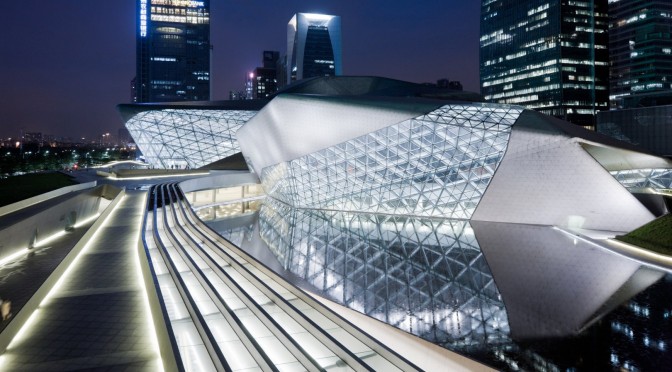
Designed by Zaha Hadid, the Guangzhou Opera House is incredibly gorgeous to look at due to the conversion of a single building into a marvelous urban environment. It is constructed in China — the country that is still undergoing cultural growing pain, meaning they could never create a mistaken product intentionally to decrease the efficiency in economical systematic plans. Completed in 2010, it has a build area of 70,000 sqm, making it quite large in space as compared to the buildings around it.
The opera house — is further shaped into an appealing vacation place. The combination of triangles is used to shield the building from the outside danger and to protect its dignity. The project acted as a vindication for Mrs. Hadid, when the government refused to pay her when she was a rising star with her few designs in mid 1990s, so the project was handed over to a lesser talent, which was devastating for her. Despite the fact the opera house might not be the “killing” design, it nevertheless attracted thousands of people due to its magnificence attention to interior design and complexity between the spaces.
Thanks to Iwan Baan, who took the marvelous photographs for us to appreciate the beauty of the design!
(Around the Gallery)
The strong support of ceiling is provided for the entrance and the passageway to the main area of the building. The power given by the materials is not only able to hold the weight of vast number of people, but also sustain the ability to provide the weight support to the rest of the building. The different sections of the building feels like the “spiral” cord from the outside. By entering the lobby, you get the experience of openness and possibility which leads to an airy, open-space as if it’s a cathedral-like room. The room is further supported by complex balconies that curve around the exterior of the 1,800-seat performance space.
(Spectators)
The front of the lobby is being wrapped around the faceted window, through which light can easily enter effectively in unison, giving the charming effects. The view of the city’s twinkling skyline can be seen at night. If you look close from the right side, you would find the “fish” pattern in the design.
(At night)
Compared to the other buildings in the surrounding, the height of the opera house isn’t very much, considering the fact that opera houses aren’t mean to be longer in heights, but rather larger in space, due to the requirements of potentially vast number of people.
(The height compared to surrounding buildings)
The biggest surprise in the design is the way the various spaces of the building are connected with each other. Two lobbies are connected to the lower plaza through escalators, which is further lined with a few shops and a cafe. Currently, only the piano shop is open, however, it is expected that other shops will open soon, which would help in further boosting the number of spectators. From the lower plaza, you can go back to the main plaza, or you can spend your time in the reflecting pool that extends toward the park.
The space in the building has sequence, which beautifully ties the opera house into the park around it, which utilizes the often not-used space. The generosity of the building manifest in the decision to make it a part of the public realm, so that it belongs to everyone, and not just for elite opera fans.
(Connection)
A huge area is left for the gymnastics section, where the people that want to take a relaxing time from the opera theater can fulfill their bodily needs and health.
(Gymnastics)
The opera theater is filled with brown layers of ceiling, suggesting the classical theme opera. You would feel the softness when you step into the main hall, as if you’ve entered inside an oyster. The asymmetrical pattern is used in the seat arrangements. The stage is enveloped on three sides, with undulant balconies cascading down in front of the stage. Thousands of little lights pierce the concave ceiling, which enable the main lights to dim before a performance which makes you feel as if you’re sitting under the dome of a clear night sky.
(Opera theater)
Below are some of the technical outlines of the building:
(Outline)
(Outline)
(Outline map of the surrounding)
(Internal layout)
(Front section)
Below are some of the 3D drawings created before the construction:
(Shiny Grillings)
(Outside)
(Inside)
(Opera)
Many properties of the Guangzhou Opera House can be summarized in following list:
In the busy streets of Guangzhou, it would be an injustice to the architecture community to not visit the shining opera house if you either have a love for opera shows or an appreciation for art. The complex inner side of the building should not keep away from people’s curiosity.
Do you live in the Guangzhou Opera House? Did you support the construction of Guangzhou Opera House? How it made you feel about your city?

Leave a Reply